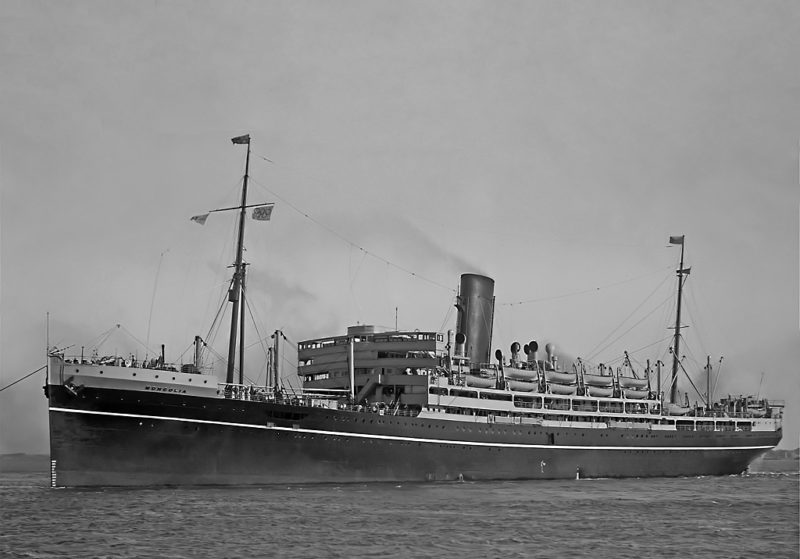
The ‘M’ CLASS P. & O. LINER WITH FIVE NAMES
Mongolia was the only P. & O. liner built during the inter-war period that subsequently had four further names of Rimutaka, Europa, Nassau and Acapulco. German unrestricted submarine warfare against British shipping during World War I had resulted in the loss of 44 fine passenger and cargo-liners of the Peninsular and Oriental Steam Navigation Co. Ltd. A huge new fleet of nineteen deep-sea passenger liners were ordered in stages for their very important Indian, Far East and Australian services to be completed by 1930, as follows:-
- A new Indian service flagship in Viceroy of India with 672 passenger berths on the Bombay direct service
- Five new Branch Line passenger steamers for the Australian service via Suez in Ballarat, Baradine, Bendigo, Barrabool and Balranald with a total of 2,455 berths plus a number of deck passengers
- Four new ‘M’ class passenger liners for the Australian service via Suez in Moldavia, Mongolia, Mooltan and Maloja with a total of 2,120 passenger berths
- Four new ‘R’ class passenger liners for the Bombay direct service in Ranpura, Ranchi, Rawalpindi and Rajputana with a total of 2,400 passenger berths
- Five new ‘C’ class intermediate passenger liners for the Australian service via Colombo and the Far East service in Cathay, Chitral, Comorin, Carthage and Corfu with a total of 1,695 passenger berths. A further superior ‘C’ class vessel was completed shortly before the outbreak of World War II as Canton, with ‘A’ deck having a complete run of First Class staterooms to accommodate a total of 480 passengers, making the total for the six ‘C’ class of 2,175 passenger berths.
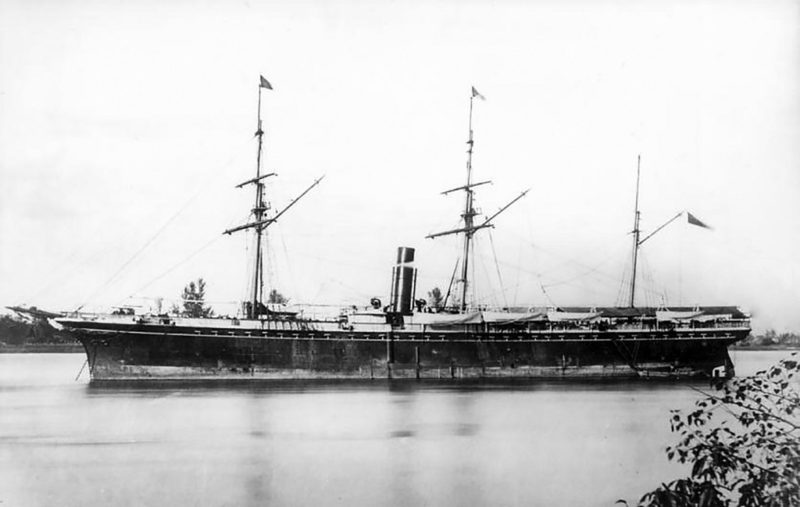
The provision of a total of 9,400 First Class and Second Class berths in brand new liners, plus 600 deck passengers on the new Branch Line steamers, to give ten thousand new passenger berths was a monumental undertaking even for this, the British premier passenger liner company. Moldavia and Mongolia were sisters that had each been ordered on 22nd November 1918 at a cost of £1 million, but their construction had been delayed due to a backlog of orders and building work. They were of overall length 573.0 feet, length between perpendiculars of 551.6 feet, moulded beam of 72.0 feet, moulded depth of 38.5 feet, and a loaded draft of 30.0 feet. There was a big drop of 89.0 feet from the top of Boat Deck to their keels. Moldavia was completed on 19th September 1922 by the Cammell, Laird & Co. Ltd. yard at Birkenhead, and Mongolia was Yard number 964 from the Armstrong, Whitworth & Co. Ltd. yard at Walker on Tyne. She was a twin screw turbine powered Intermediate Class liner of 16,504 grt, and was launched into the Tyne on 24th August 1922, with the naming ceremony performed by the Hon. Elsie Mackay, daughter of Lord Inchcape, the chairman of the Peninsular & Oriental Steam Navigation Co. Ltd.
Amongst the launch party present were Sir George and Lady Hadcock, Major F. M. Lowe, Mr. & Mrs. Dalziel Nevin, Mr. & Mrs. Alfred Cochrane, Mr. & Mrs. Wilfred Cochrane, Mr. & Mrs. H. Williams, Mr. & Mrs. P. Collier, Mr. & Mrs. H. Thomson, and Mr. & Mrs. E. W. Swan. Mr. R. T. Clarke had superintended the construction of the ship from keel laying for P. & O., and Mr. A. Clarke, her Chief Engineer was also present. There were also representatives of Lloyd’s Register, the Board of Trade, and the British Corporation Ltd. present, plus officers of the Cunard Line passenger ship Ausonia, which was on the point of leaving the Walker Naval Yard after completion. Mongolia completed her full speed trials on 25th April 1923 when a top speed of 17.6 knots was achieved, her service speed being 16.0 knots.
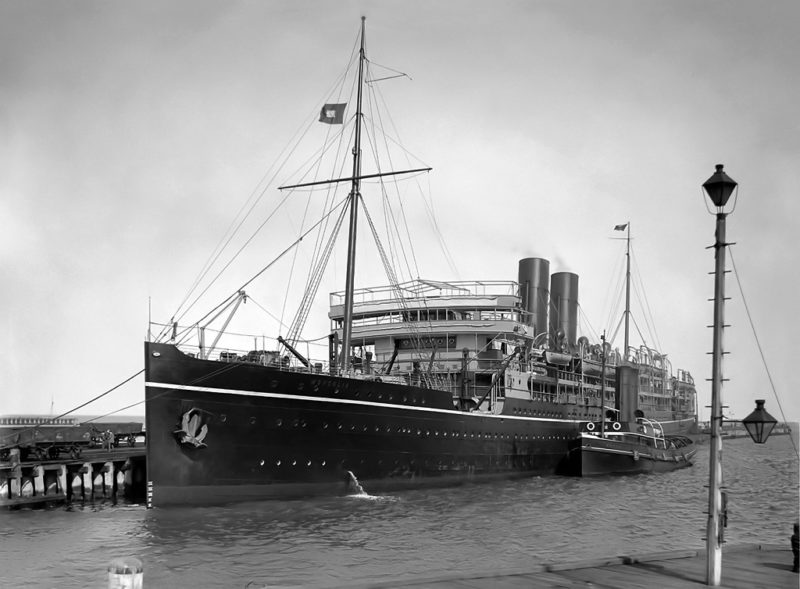
Mongolia and Moldavia were built for the Australian service of P. & O. and provided a monthly service, which was reduced to fortnightly with the introduction into service of Mooltan and Maloja at the end of December 1923. They had accommodation for 231 First Class passengers and 180 Second Class passengers, as well as a large cargo carrying capacity of 669,000 cubic feet with a deadweight of 13,500 tons, and a counter stern. The cellular double bottom of length 476.0 feet ran the full length of the ship from fore peak to aft peak, and had tanks for 2,858 tons of water ballast including those in the fore peak and aft peak, and tanks to the side of the propeller tunnels. She had ten bulkheads that reached up to Shelter Deck, and seven cargo holds.
Mongolia was named after the historical province of China that became an independent country after a Russian backed revolution in 1921. Moldavia was named after a historical East European region next to Moldova with both names derived from the Moldova river. Mooltan was named after the Mooltan regiment of the Anglo-Indian Army that destroyed the last Sikh army at the end of the Sikh Wars at the Battle of Gudjarat on 21st February 1848. Maloja is named after a pretty village at the head of the Engadine region of Switzerland, and famous for skiing and as a holiday resort.
Moldavia and Mongolia were coal burners that were converted to burn oil fuel in 1928, raising steam at 200 pounds per square inch in three double and four single ended boilers to pass to six steam turbines with two sets of high pressure, intermediate pressure and low pressure turbines. The turbines of Mongolia were manufactured by the Elswick yard of Armstrong, Whitworth & Co. Ltd., upstream from the soon to be completed Tyne Bridge. They had five steel decks, with two steel decks lower down in the hull, plus the steel Shelter Deck with freeboard, and the steel Shade Deck covered with teak, and Promenade Deck. Above Promenade Deck was the Boat Deck with sixteen lifeboats, some double banked, of 28 feet in length, and two motor lifeboats of 30 feet in length, which were specially fitted for taking lifeboats in tow and were equipped with radio telegraphy to bring rescue ships to their aid. Above Boat Deck were the Lower Bridge Deck, Navigating Bridge Deck, with the compass platform on top.
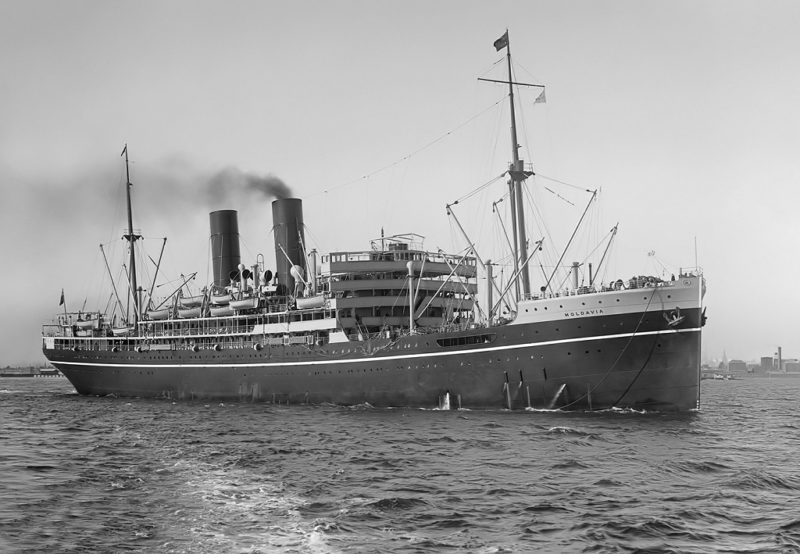
Number five hold had insulated cargo capacity of 136,000 cubic feet in its lower half to carry meat homewards from Australia, and her two masts and three sets of posts carried twelve three ton, four ten ton and a heavy lift derrick of thirty tonnes capacity on her fore mast to serve numbers two and three holds forward. She carried a big crew of 353 officers and men, to give, when a full load of passengers was carried, a total of 764 persons onboard. Mongolia was built to meet the full requirements of the International Convention on the Safety of Life at Sea (SOLAS), and was classed 100A1 at Lloyd’s Register with a passenger certificate from the Board of Trade. She was equipped with the latest navigational aids on her bridge including radio and direction finders.
The ‘M’ class liner Mongolia completed in April 1923 on the Tyne, was the third of her name in the big P. & O. fleet. The first was a fine triple masted steam and sailing ship built by Scott & Company of Greenock in their East Cartsdyke yard as yard number 106. She was launched on 1st March 1865 and completed in August 1865, and measured 2,799grt on dimensions of overall length 319.4 feet, moulded beam of 40.2 feet, and moulded depth of 32.7 feet. She had accommodation for 171 passengers, and was completed for the Calcutta to Suez route as the soon to be completed Suez Canal of 1869 was not yet ready. She was re-engined by Day, Summers & Company at Southampton in 1874, and then served on the Indian and Australian routes via the Suez Canal until transferred to the Venice to Bombay route in 1878. She was sold at Bombay in November 1888 for breaking up.
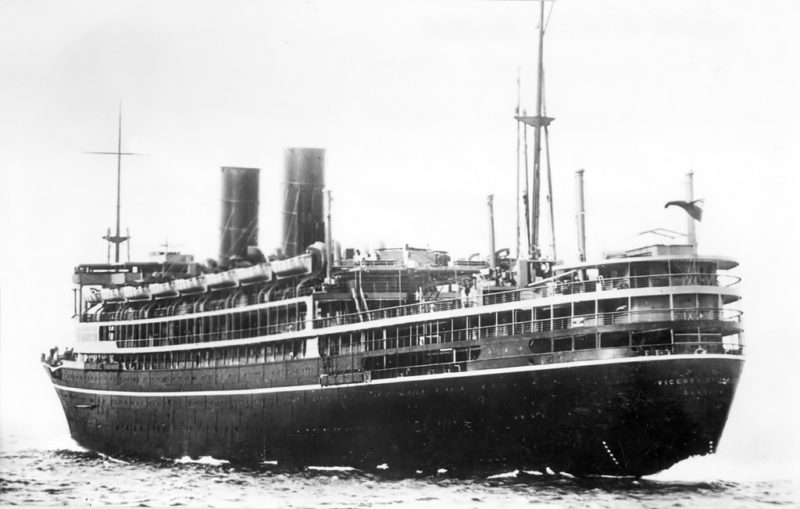
The second Mongolia was a twin funnelled much bigger liner of 9,505grt completed by Caird & Company at Greenock on 16th October 1903 for the Australian service via the Suez Canal. She had six holds served by ten hydraulic cranes and had accommodation for 348 First Class and 166 Second Class passengers. In 1904, she was stopped in the Red Sea by Russian cruisers and searched as Russia was at war with Japan. She was severely damaged by fire in 1908, but was repaired and put back in service. She was sunk by a mine on 23rd June 1917 laid by the German raider Wolf, with 23 lives lost in three passengers, three engineering officers, fourteen native and three European crew members, with the precious mail bags also lost.
The third Mongolia sailed from London on her maiden voyage down the Thames on 11th May 1923, and she was fully booked with passengers and migrants heading for new lives in Australia. As the time of departure arrived, her decks were packed with passengers while family and friends filled the quay below, and paper streamers connected the two groups. The ship’s orchestra played and after sounding her siren three times, she moved sideways off the quay under the control of tugs. The streamers broke the last bond between loved ones, some would never see them again. The brand new ship had a new crew and a new Master on her bridge, and the emotions of leaving were soon forgotten as she sailed for calls at Plymouth, Gibraltar, Tangiers, Marseille, Port Said, Aden, Bombay, Colombo, Fremantle, Adelaide, Melbourne, Sydney (NSW) and Brisbane as the final port of call.
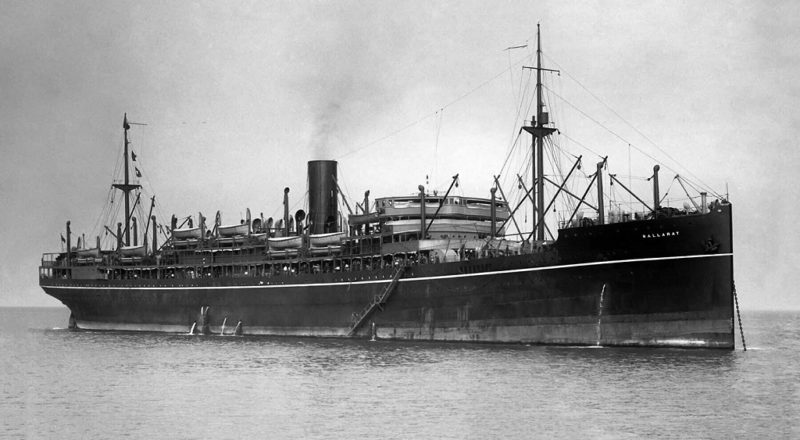
PUBLIC ROOMS OF ‘M’ CLASS
MONGOLIA
Mongolia had a fo’c’sle of length 54 feet on Shade Deck, and a Promenade Deck of length 368 feet in the main superstructure, where most of her public rooms were located. The traditional wheelhouse on the navigating bridge was constructed of mahogany, and there were two conning positions to port and starboard on the flying wings of the bridge. The elegant and beautifully timbered First Class Main Lounge on Promenade Deck contained round tables of some quality with decorated tops and strongly backed carver easy chairs. The ceiling and strengthening vertical pillars were covered in light coloured panelling, and the painting of the walls and the floor carpets matched the same colour scheme.
Next to the First Class Lounge on Promenade Deck was the elegant First Class Card and Writing Room, with lattice wooden panelling and its domed ceiling in the centre, giving a beautiful stained glass roof to view Boat Deck above. The room was beautifully decorated and had many wooden writing tables and cane easy chairs and carver upright chairs. The many windows, made to the classic 3 by 4 glass pane design, of the public rooms along Promenade Deck looked out on a fine, wide and long promenading space to port and starboard.
The First Class Smoking Room was located far aft on Promenade Deck, and had beautiful windows on three sides. The room was built of timbered supports and ceilings, with heavy wooden tables and fine, deep leather lounge chairs, and many other quality fittings and furnishings such as those found in the four discreetly hidden alcoves of the room.
The First Class Dining Room was located on Shelter Deck and had wooden tables for four, six or eight diners, with special long tables for parties of twenty passengers. All of the chairs were designed with oval open backs and four curved slats of wood in the middle for strengthening. The room was lit by many ‘peardrop’ shaped glass lights on the ceiling as well as copious amounts of natural light from the many portholes of this full width beautiful room.
The First Class Double Berth Cabins had a chest of four drawers with a mirror above and two bunk beds arranged one above the other. A wardrobe and various metal fittings for the hanging of clothes were included, but toilet facilities were down the corridor. The Second Class Four Berth Cabins were remarkably the same as First Class Double Berth Cabins with the same chest of drawers with a mirror above and twin bunk beds arranged one above the other on each side of the cabin. The carpets and easy chairs again were the same for both classes of cabin.
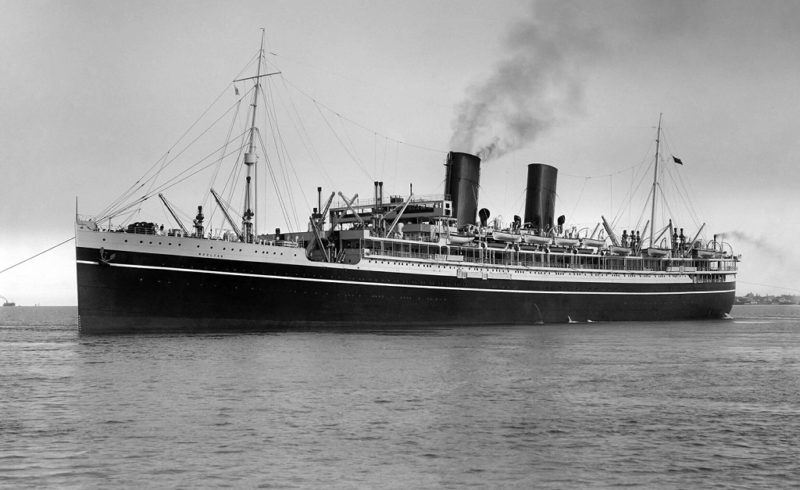
THE ‘M’ CLASS LINERS IN SERVICE
The second group of sisters, Mooltan and Maloja, were slightly larger than Moldavia and Mongolia at 20,850 grt with accommodation for 327 First Class passengers and 329 Second Class passengers. They joined Moldavia and Mongolia at the end of 1923 to provide a frequent fortnightly service to Australian ports. In 1928, it was decided to convert Mongolia to oil burning with an oil flash point above 150 degrees Fahrenheit, which gave a better speed and performance as she continued on her successful inter-war years career.
Mongolia received her engines at the Elswick yard on the Tyne and sailed under the beautiful arch of the Tyne Bridge at Newcastle while it was still in the early construction stage, but also sailed many times in the early 1930s under the construction stages of the longer beautiful arch of the Sydney Harbour Bridge of length 1,650 feet, completed in 1932 after eight years of construction by 1,400 workers, with the contract awarded to the Teesside steel company of Dorman, Long & Co. Ltd. The Sydney Harbour Bridge features four railroad tracks, a highway, and two pedestrian walkways and bicycle lanes along its length. By comparison, the Tyne Bridge is of length 1,276 feet including approaches, and was designed by engineering company Mott, Hay and Anderson and was built of steel by Dorman, Long & Co. Ltd. with expertise input from the Cleveland Bridge Company. The Tyne Bridge has a clearance of 85 feet above the river Tyne with a single long arch span of 531 feet, and was opened on 10th October 1928 by King George V and Queen Mary.
Mongolia unfortunately collided on 16th July 1936 with the tanker British Venture of the Anglo-Persian Oil Co. Ltd., which later became British Petroleum (BP) in 1951. Damage was repaired, as well as the grounding damage from a later collision with a breakwater at Copenhagen. Mongolia collided on 3rd December 1936 with the white hulled motor ship Villa de Madrid of Compania Trasmediterranea of Spain while approaching Marseille harbour. Little damage was done to either ship and was quickly repaired, but the collision occurred during the Spanish Civil War when Villa de Madrid was operating as a liaison ship between Barcelona and Marseille for the two opposing factions of the Nationalists and the Democrats. Villa de Madrid had been completed in 1931 by the Krupp Germania Werft A.G. yard at Kiel, and survived the war to be rebuilt from the middle of 1959 until July 1962 with a more modern profile. She completed a magnificent 48 years of service when she was sold for breaking up in 1979. The larger motorship sisters Domine and Fernando Po of 6,914 grt were completed in 1936 as the flagships of the State-owned company, Fernando Po being lost during the war.

All the accommodation of the ‘M’ class Australian liners of P. & O. were designated as Tourist Class in 1930. Moldavia gained a dummy second funnel in 1928, and six years later she had replacement propellers fitted with steam superheaters added to her steam turbines to give a greater service speed of 17.5 knots. Mooltan and Maloja were fitted during 1929/30 with Bauer-Wach exhaust turbines to give a similar boost in service speed to 17.5 knots. The career of Moldavia was cut short in 1937 when she sailed from the Thames on 17th September for Australia, and on her return she was laid up for a short time before arriving at Newport for breaking up in April 1938.
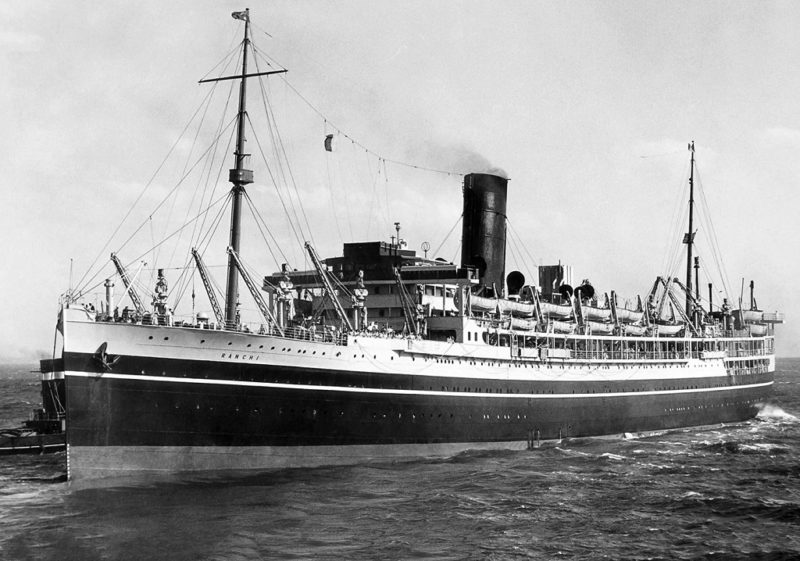
RIMUTAKA
Mongolia was dressed overall with flags when she arrived in Sydney Harbour for the last time early one day in May 1937 for P. & O. She was laid up at London on her return and put up for sale, but no buyers were forthcoming, and she was transferred on charter to the New Zealand Shipping Company, a member of the P. & O. Group, on 7th May 1938 and renamed Rimutaka and given a yellow funnel. This company had been formed in London in 1873, with the first Rimutaka being a ship with a clipper bow and three masts and built in 1884 of 4,474 grt, and which was sold on to British India Line in 1900 and renamed Zamania. Rimutaka (2) was built in the same year of 1900 by the Denny yard at Dumbarton on the Clyde of 7,765 grt with two masts. She carried her fair share of the increasing general cargo, wool and refrigerated meat trade via the Panama Canal of the company for almost thirty years until the end of 1929 and was broken up in 1930.
Rimutaka (3), the former Mongolia, was reconfigured in her accommodation at the start of her charter to the New Zealand Shipping Company to carry 840 Tourist Class passengers with all of her public rooms completely upgraded, with her registry changed to Plymouth. She collided with the William Cory & Sons Ltd. of Newcastle and London collier Corfleet off the Nore in November 1938. She sailed on a regular service from London via the Panama Canal to Auckland and Wellington, the terminus of the service, but with occasional visits to Lyttelton at Christchurch and Port Chalmers at Dunedin on South Island. She suffered a fire in number three hold on 9th March 1939 in the Panama Canal when passing though the Miraflores locks and the Gaillard Cut, but this was rapidly extinguished and no damage was done.
Rimutaka (3) was requisitioned in September 1939 by the British Government for possible conversion to an Armed Merchant Cruiser (AMC) but this was cancelled, and instead she was put under the ‘Liner Division’ and reverted to her U.K. to New Zealand service from 15th May 1940 until 14th June 1946, and manned by her original New Zealand Shipping Company crew. In 1944, she carried the Duke of Gloucester to Australia to become Governor General of the nation. The two other surviving ‘M’ class, Mooltan and Maloja, served as AMCs and troopships to take part in landings to North Africa in Operation Torch. The big twenty ship troopship of 26th October 1942 to North Africa contained no less than five P. & O. liners in Mooltan, Cathay, Ettrick, Strathnaver and Viceroy of India. After June 1946, Rimutaka officially returned to the ownership of the P. & O. but still on charter to the New Zealand Shipping Company, with the same main ports of Auckland and Wellington, and occasional visits made to Lyttelton and Port Chalmers on South Island.
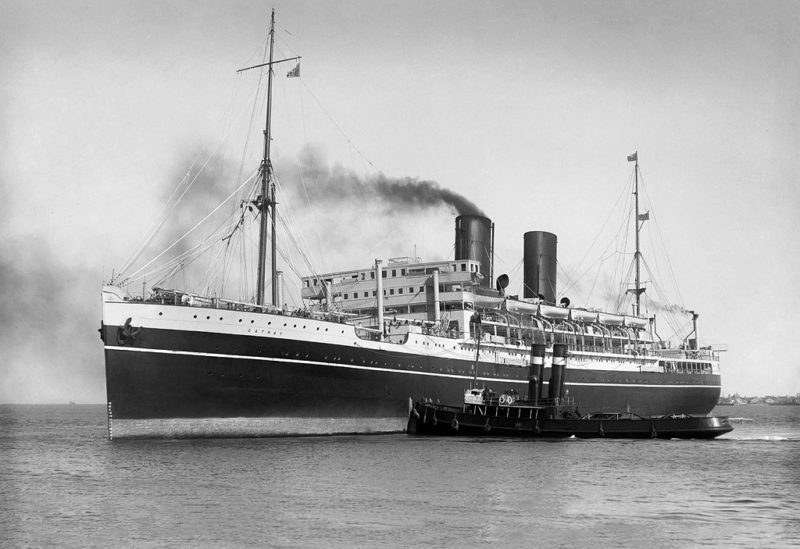
EUROPA AND NASSAU OF INCRES LINE
Rimutaka had served eleven years on the U.K. to New Zealand service when her charter ended, as P. & O. had already secured a buyer for her for £95,000, and she was sold on 10th January 1950 to Compania de Navegacion Incres S.A. of Panama and was renamed Europa. The new owners converted her to take just 614 Tourist Class passengers for a Transatlantic service transporting refugees and migrants from Europe to the U.S.A. and Canada. The insulated cargo space in number five hold was stripped out and half of her Promenade Deck was glazed in to protect passengers from rough Transatlantic seas. She sailed from Genoa and later from Antwerp, and Le Havre with a call at Plymouth to collect British migrants. She still wore the yellow funnel of the New Zealand Shipping Co. Ltd. and a black hull.
Europa remained on this Transatlantic service until the end of September 1951, when she was sent to a shipyard in Genoa for a major and radical conversion into a cruise liner. She was renamed Nassau after the port in the Bahamas which she would be cruising to from New York on a weekly year round service from the end of 1951. The general passenger agents for the Incres Line schedule were the Arnold Bernstein Shipping Co. Inc of Battery Place on the waterfront in New York. She now measured 15,043 grt when she underwent Special Survey at New York in December 1954.
All of her passenger cabins were refitted to a luxury standard of suites and cabins, the suites having private sitting rooms, and those on Promenade Deck and Main Deck had private bathrooms and facilities. Nassau was given full air conditioning in her public rooms, suites and cabins, and her three aft cargo hatches were removed to provide a lido deck with two swimming pools flanked by orange reclining li-lo beds and striped parasols. A new deckhouse was built right aft to her counter stern, with a sunning and sports area above. The Lido Bar was informal with comfortable seats for relaxing cocktails and drinks with new and old friends.
Panoramic windows provided excellent observation points for the activities taking place on the Lido deck aft. The Lido bar had red and white striped covers on its top, while the wooden bar surface and the vertical sides had panels made from wood of three different colours. The Bamboo Room nearby served coffee, tea, mineral waters during the day, and in the evening, it provided a secluded place for couples dancing to the ship’s orchestra.
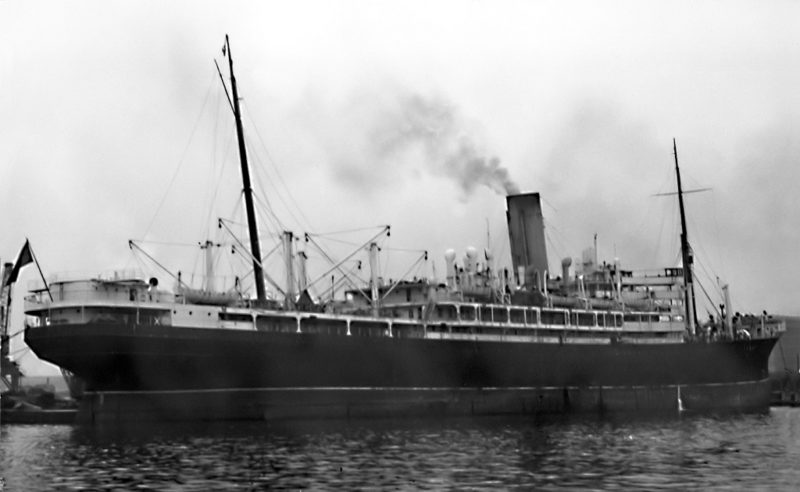
Nassau was registered in the port of her name, and had a white hull with a blue ribbon line and green boot topping, and her funnel was yellow with a blue top. The navigating bridge had all of the latest aids to navigation including direction finders, electric signalling devices, gyrocompass and radar. She had six passenger decks with a good selection of luxury public rooms all located on the Upper Promenade Deck, except the Grand Dining Room which was located beneath the Promenade Deck on ‘A’ deck, with entrance doors at the forward Entrance Lobby. The six passenger decks were named as follows:-
- Boat Deck with officers and Master’s accommodation, with open space for games and the same number of lifeboats as before.
- Upper Promenade Deck with all of the main public rooms except the Grand Dining Room.
- Promenade Deck with four Deluxe suites forward with separate lounges, and other suites and cabins stretching aft to the open lido deck and swimming pools, the best attraction on the ship.
- Main Deck had two Deluxe suites forward with separate lounges, and other suites and cabins filled the remainder of the deck up to the counter stern.
- ‘A’ Deck had the Grand Dining Room and cabins with no private facilities.
- ‘B’ Deck had cabins with no private facilities.
The Main Lounge was forward on the Upper Promenade Deck and had lovely wooden panelling of a light colour, with blinds and curtains to the windows. Small round coffee tables were placed in the middle of groups of sofa chairs, upholstered in either pink or a light biscuit colour with brown, white and red thin stripes. Chess, cards, backgammon and other games were played on these tables by passengers, who also just relaxed in the deeply upholstered chairs.
The Verandah Room aft on Upper Promenade Deck had gaily coloured tables and informal chairs for seating while playing games of all types, and it also hosted the occasional concert. This was an informal ‘fun’ room for the long hours of leisured cruising.
First Class Staterooms from Promenade Deck downwards came in a wide and varied selection of cabins, from larger two bedded rooms to magnificent Deluxe cabins having a private lounge and private facilities.
The Grand Dining Room on ‘A’ Deck had tables for four, six or eight diners seated on blue backed carver chairs, with fresh flowers on most occasions, and orange curtains drawn across the windows each evening. This room was very spacious and elegant, serving Italian style food and desserts prepared by Italian chefs.
The mostly American cruise passengers became repeat cruisers, as the luxury accommodation for 614 First Class passengers was well received, and the ship remained in the same cruise trade from New York to Nassau for a decade until she was sold again at the end of 1961. The Incres Line cruise brochures optimistically described the Port of Nassau in the Bahamas as an all the year round resort with almost perpetual sunshine. A ride on a carriage up Bay Street, a swim at Paradise Beach, and a stay at a fine, modern hotel or guest house, was accompanied by calypso music and great shopping bargains to be had. The Nassau cruise ship was very comfortable, a home from home, with every convenience designed to make life onboard a pleasure. All requests and wishes to staff were fulfilled, every command or desire was carried out by attentive, efficient and gracious Italian stewards.
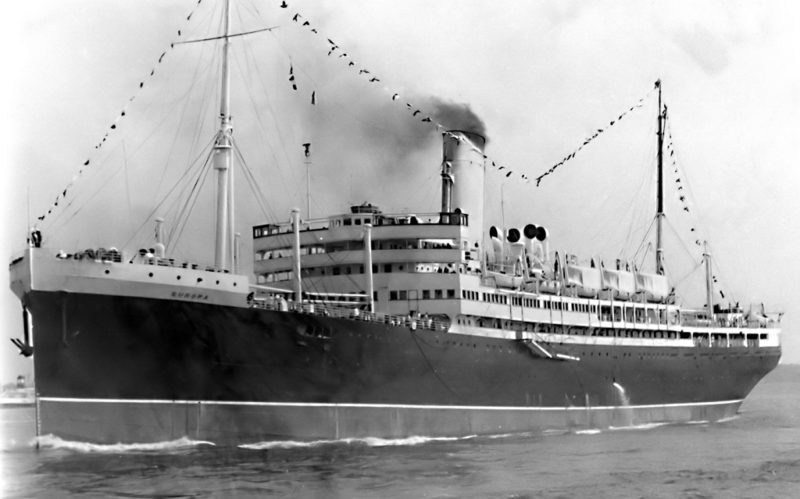
ACAPULCO CRUISE SHIP OF NATUMEX LINE
The former P. & O. liner Mongolia was purchased in 1961 by Compania Navegacion Turistica Mexicana S.A. or Natumex Line for short, and was renamed Acapulco. This company was 80% owned by the Mexican Government and 20% by private capital, with the intention of providing a fortnightly cruise service between Los Angeles and Acapulco in Mexico. There was a lot of advertising and media attention for this new cruise circuit, never before attempted, offering citizens of California the opportunity to holiday in Acapulco with a free shore excursion to Mexico City included in the fare.
Acapulco, now of 15,182 grt, sailed on her first maiden Mexican cruise on 20th January 1962 with Natumex Line having spent a reported U.S.$1 million on updating the ship on a big refit at the Fairfield Shipbuilding & Engineering Co. Ltd. yard at Govan on the Clyde, where she also underwent her Special Survey. She now had accommodation for 610 one class passengers, with very large block capitals proclaiming her name around the front of her Promenade Decks. She had a white hull and funnel with two blue thin bands at the top of the funnel together with a thin black top. She failed her first inspection by the United States Coast Guard, but this was rectified within days to allow her to sail on her maiden cruise to Acapulco.
Acapulco suffered an engine breakdown at sea on her third cruise, but her old engines were soon persuaded to move her again, and she was quickly back in service. She was used as a hotel ship at the Seattle World Exhibition, known as the ‘Century 21 Exhibition’ at Seattle in 1962. However, not enough Californian citizens were prepared to cruise just to Acapulco, and she was laid up at Manzanillo in Mexico at the end of the 1963 cruising season. She was put up for sale in December 1964, but no bids were forthcoming for the old ship. She left Manzanillo under tow in late 1964 and arrived at Osaka in Japan on 15th December 1964, with demolition of the world travelled liner begun on 6th January 1965.
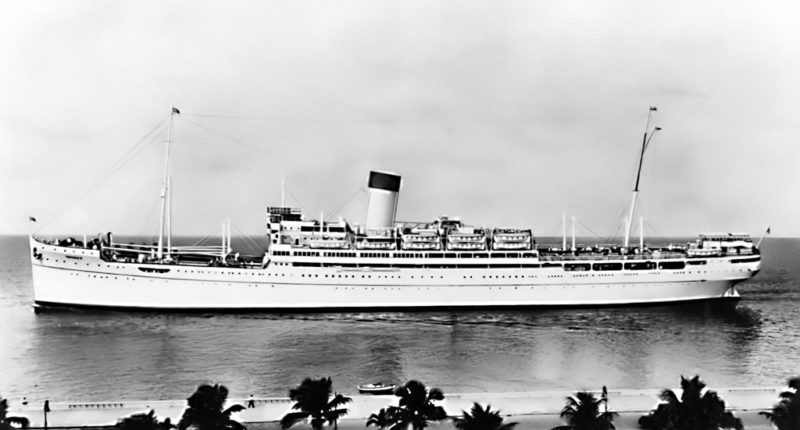
SUMMARY
Mongolia of the ‘M’ class of Intermediate liners of P. & O. had a long and magnificent career of 43 years under five names. She had outlasted her sisters by a decade, with Moldavia having only a very short career of fifteen years, Mooltan having a career of 31 years before she was broken up at Faslane in 1954, and Maloja also having a career of 31 years before she was broken up at Inverkeithing in 1954.
Mongolia had become a very successful cruise ship for a full decade on the important and well patronised cruise trade from New York to Nassau under the name of Nassau, but when it came to pioneering a new cruise trade from Los Angeles to Acapulco she only lasted in service for two years under the name of Acapulco.
The Acapulco was partnered by the former Union-Castle Mail Steamship Co. Ltd. Dunnottar Castle of 15,054 grt, and built in 1936 by the Belfast yard of Harland & Wolff Ltd. She was given the name Victoria in the Incres Line fleet when she joined in 1958, and carried 216 First Class passengers and 236 Tourist Class passengers. She was rebuilt by the Wilton-Fijenoord yard in Rotterdam, and her steam engines were replaced by a Fiat oil engine of 16,800 bhp to give a cruising sped of 18 knots. She made her positioning voyage to New York on 8th January 1960, and was placed in cruise service from New York to the West Indies. She was sold by Incres Line in 1964 to Clipper Line A/B of Sweden, and continued her long cruising career for Chandris Line as The Victoria, and in 1993 for Louis Cruise Line of Cyprus as Princesa Victoria.
She was finally broken up in 2004 at Alang in India after a magnificent 68 years of service.
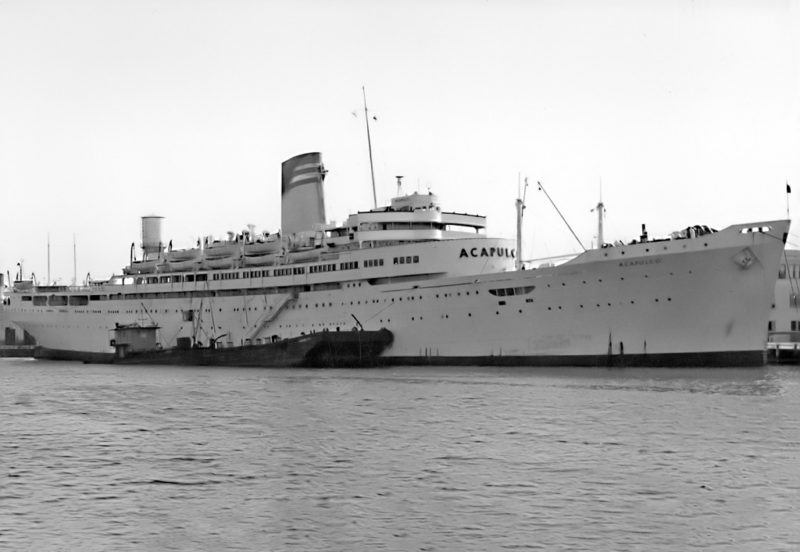





Comments
Sorry, comments are closed for this item